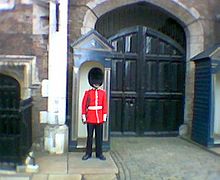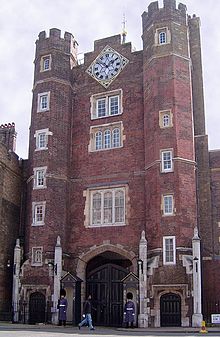St James's Palace

St. James's Palace is one of London's oldest palaces. It is situated on The Mall in London, just north of St. James's Park.
History
The palace was commissioned by Henry VIII, on the site of a former leper hospital dedicated to Saint James the Younger (from whom the Palace and its nearby Park take their names); the hospital was disbanded in 1532.[1] The new palace, secondary in interest to Henry's Whitehall Palace, was constructed in the red-brick Tudor style around four courtyards: its gatehouse survives on the north side, flanked by polygonal turrets. It became the principal residence of the monarch in London from 1698, when Whitehall Palace was destroyed by fire, and became the administrative centre of the monarchy (a role it still retains). Mary I died there, with her heart and bowels being buried in the palace's Chapel Royal. Elizabeth I was said to have spent the night there, whilst waiting for the Spanish Armada to sail up the channel. Charles I slept rather less soundly -- as it was his final bed before his execution. Oliver Cromwell then took it over, and turned it into a barracks during the English Commonwealth period. It was then restored by Charles II (Charles I's son), who also laid out St. James's Park.

The first three Georges used St. James's Palace as their principal London residence even though it was far from grand for the city palace of a major European monarchy; Daniel Defoe called it "low and mean" in 1725. In 1809 a fire destroyed part of the palace, including the monarch's private apartments at the south east corner. These apartments were not replaced, leaving the Queen's Chapel in isolation, and Marlborough Road now runs between the two buildings. George III had purchased Buckingham House – the predecessor to Buckingham Palace – for his wife back in 1762, and St. James's continued to decline in importance in the first half of the 19th century. It increasingly came to be used only for formal occasions such as official receptions, royal marriages, and christenings. Queen Victoria formalised the move in 1837, ending St. James's status as the official residence of the monarch. Some structures and interiors survive by Sir Christopher Wren and William Kent, but most was remodelled in the nineteenth century. William Morris and his firm were commissioned to redecorate the Armoury and the Tapestry Room, 1866-67.[1]

Today
St. James's Palace is still a working palace, and the Royal Court is still formally based there – foreign ambassadors are still accredited to the Court of St. James's, even though they are received by the monarch at Buckingham Palace. It is also the London residence of the Princess Royal and Princess Alexandra, The Honourable Lady Ogilvy. The Palace forms part of a sprawling complex of buildings housing Court offices and officials' apartments. The complex includes York House, the former home of the Prince of Wales and his sons, the Princes William and Harry, Lancaster House, which is used by HM Government for official receptions, as well as the nearby Clarence House, the home of the late Queen Mother and now the residence of the Prince of Wales.
The Queen's Chapel, built by Inigo Jones, adjoins St. James's Palace. While the Chapel is open to the public at selected times, the palace is not accessible to the public. St. James's Palace is one of the four buildings in London where guards from the Household Division can be seen (the other three are Buckingham Palace, Clarence House and Horse Guards).
References
External links
- The Royal Household: about St James's Palace
- Nikolaus Pevsner, The Buildings of England: London 6: Westminster (2003), pp 594-601
- St James's Palace tourist guide
